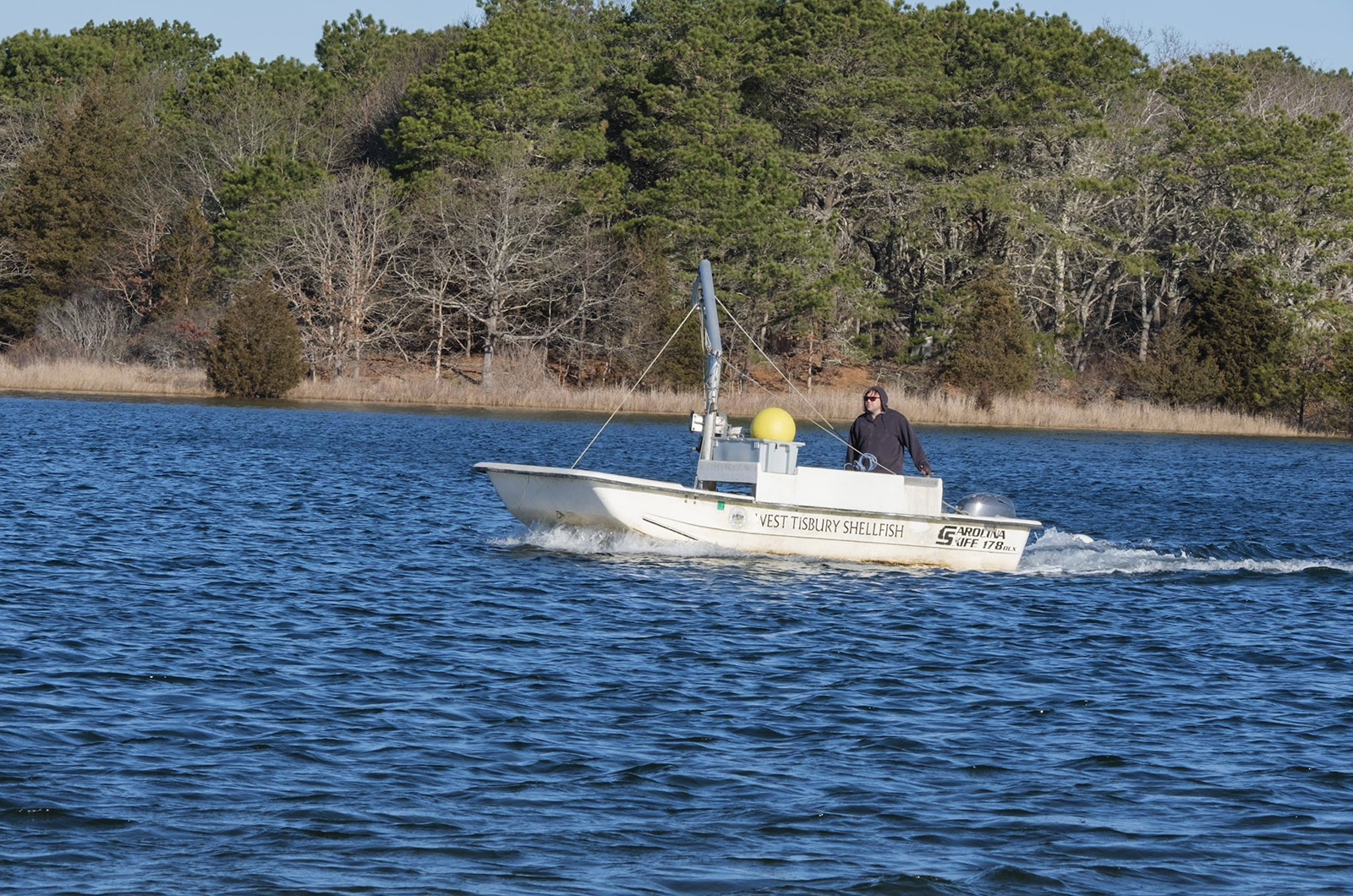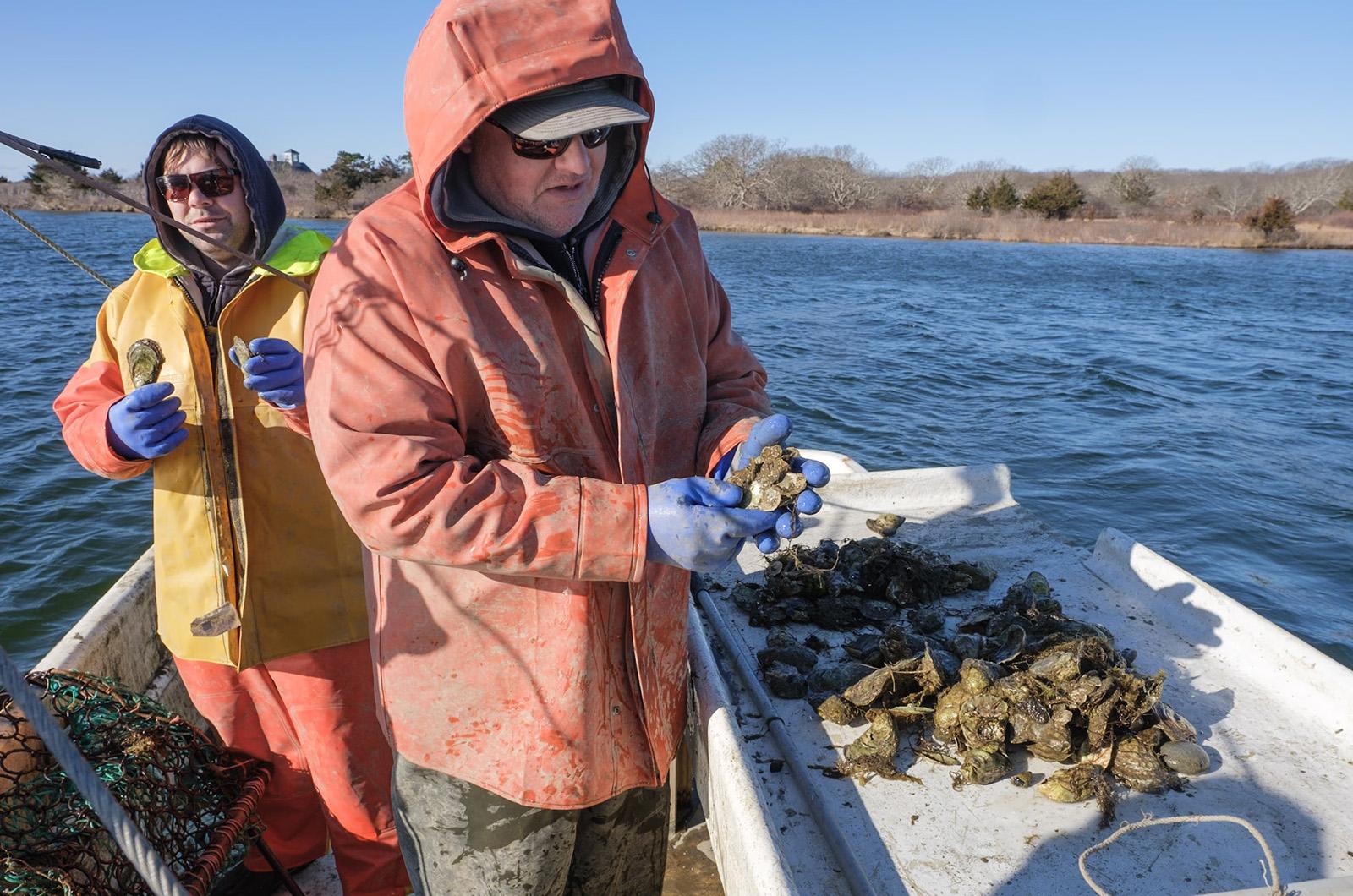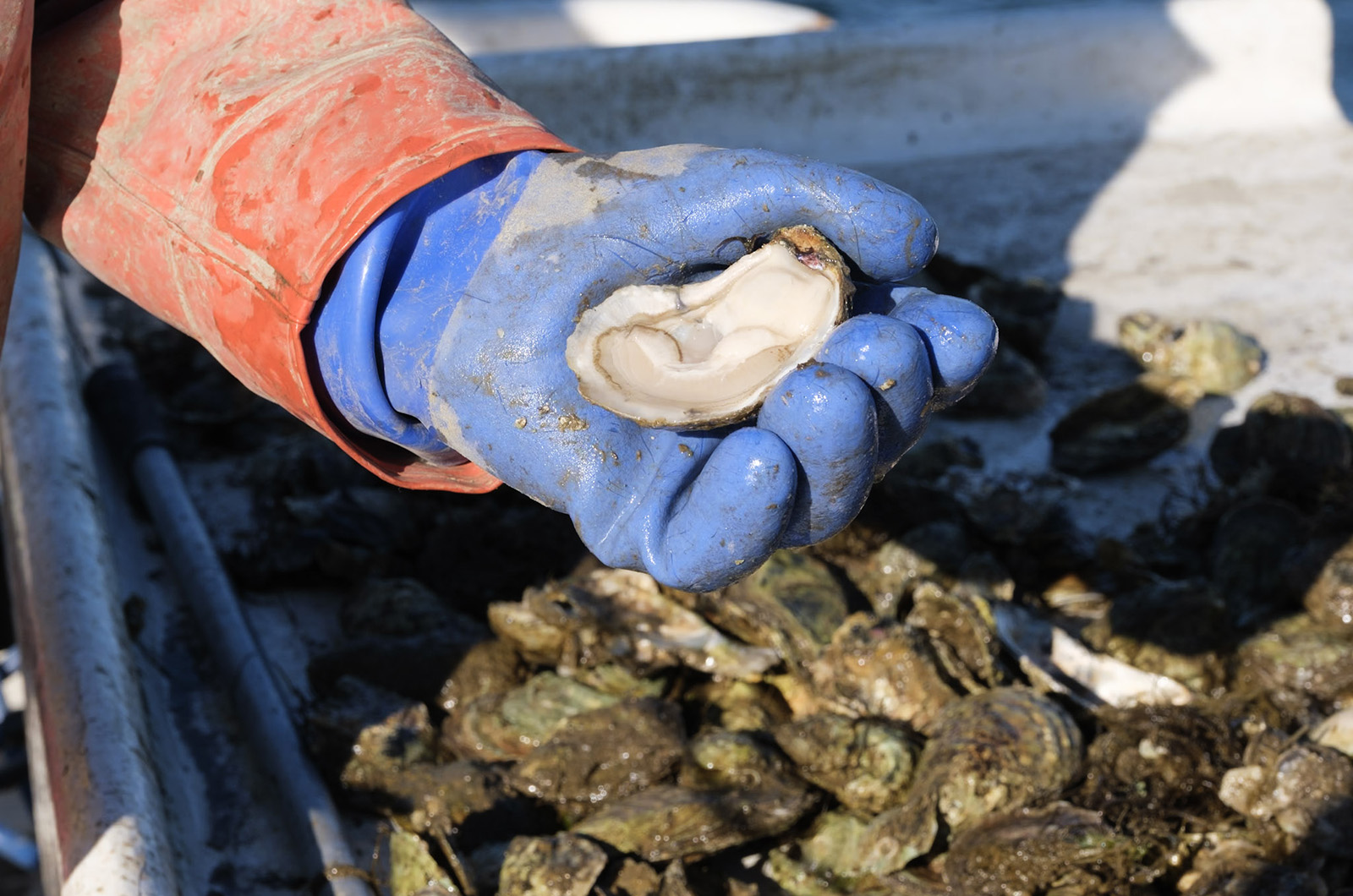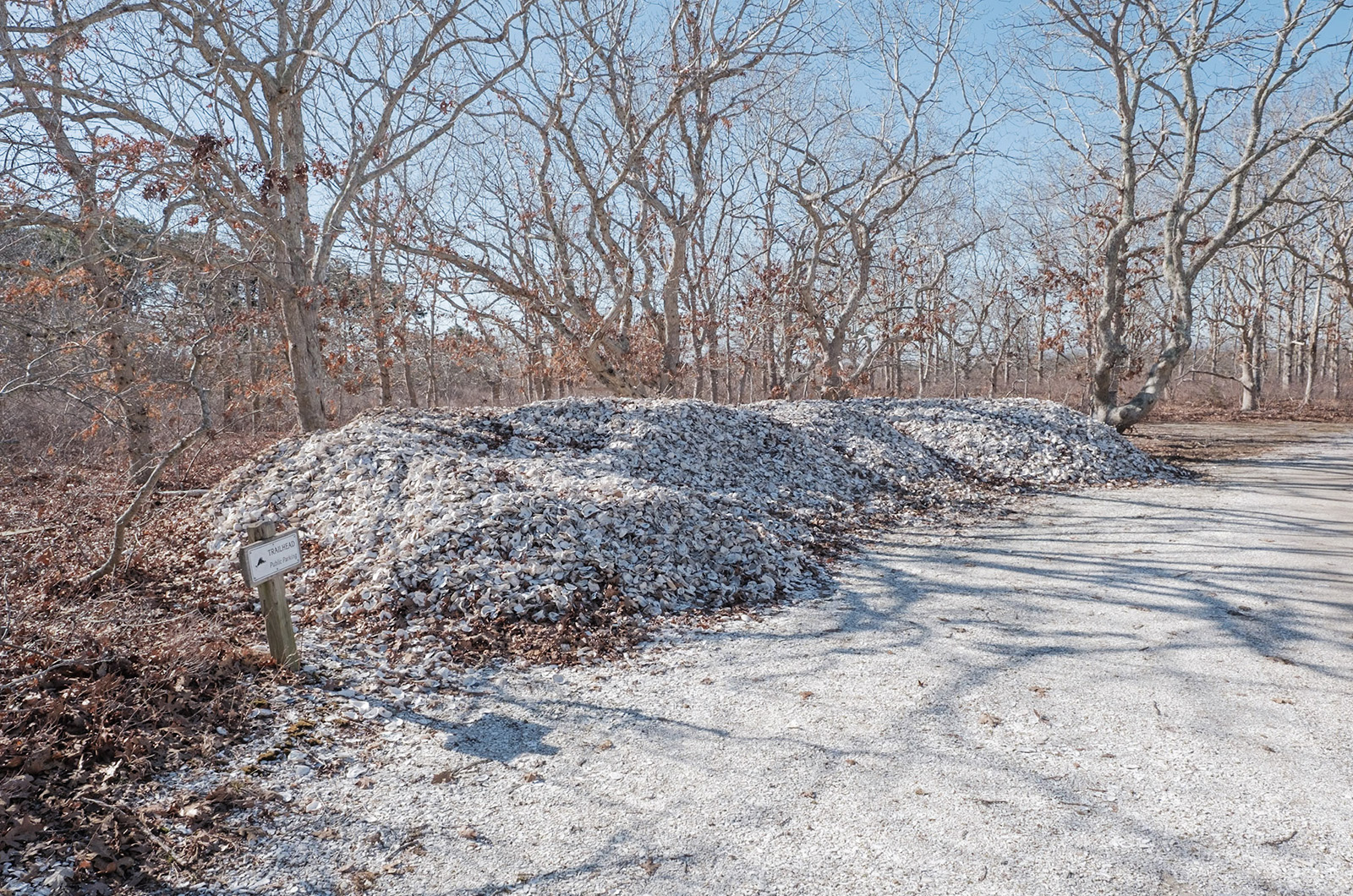On deck in a scuffed-up skiff rocking in the wind on Tisbury Great Pond, Chilmark shellfish constable Isaiah Scheffer emptied a metal-and-nylon dragnet of its scraggy, weathered wild oysters on Tuesday morning.
Dark green and gray, slick with algae, pocked with parasitic scars and polychaete worm tunnels, these bivalves are survivors, fighting everything these brackish waters throw at them.
But it was not the adult shellfish Mr. Scheffer had come to see. It was the juveniles he sought, dime-sized baby oysters attached to their older relatives. The preponderance of young bivalves this year, the constable said, is a bright spot for an embattled fishery.
“We haven’t had very many good seed sets in the last seven, eight years,” he said. “This past summer was the first year that we had a pretty decent seed set....It looks healthier this winter than I’ve seen in a long time.”

Despite the improved conditions among some Island wild oyster populations, Island shellfish officials say participation from local commercial shellfishermen was low this winter season. The burgeoning aquaculture industry continues to dominate the oyster market, whereas wild oysters often face an uphill battle.
“Our oyster market over the last couple of decades has changed a lot, and it’s moved towards an aquaculture product,” said Edgartown shellfish constable Rob Morrison. “There’s a consistent supply to the markets...and it’s a high-quality product.”
Farm-raised oysters, often grown in saltier (and cleaner) waters than their natural habitat, can be grown more consistently to a larger size, and often have a brinier flavor than their wild relatives, Mr. Morrison said. When the wild oyster fishery was thriving, he said, they would be shucked and sold by the pint, but as oysters on the half shell have become more popular, farm-grown oysters with healthier-looking shells have become the standard.
“Wild oysters that grow in clumps, they’re not that pretty,” he added. “And depending on when the ponds open, they’re not always really salty, and they have worms that live in the shells.”
Nevertheless, wild or semi-wild stock continues to show potential as a secondary commercial — along with recreational — fishery in the Great Ponds and Sengecontacket.
The unique flavor of Great Pond oysters, in particular, has its fan base.
“They’ve got the original oyster flavor,” said Menemsha Fish Market owner Stanley Larsen, who sells oysters from Tisbury Great Pond and Sengecontacket. “Wild oysters, you can’t beat that when it comes to frying.”
Wild oysters generally sell for a lower price than farmed ones, Mr. Larsen added, with the cost-per-oyster hovering around $1.25.
“As far as selling them off-Island, they’ll laugh at you,” said Ray Gale, West Tisbury shellfish constable.
Harvesting local wild oysters for sale on and off-Island was once a lucrative practice. In the 1940s, one fisherman could harvest as many as 2,000 oyster bushels from the Tisbury Great Pond, a body which now seldom nets more than 250 commercial bushels.
Wild oysters, too, were a key fishery in Edgartown, where scallopers could easily shift to dragging for oysters in a slow season.
“The Great Pond wild oyster population has fluctuated over the years for a variety of reasons. Diseases, harvest methods, overall health of the pond, this, that and the other thing,” Mr. Morrison said. “I think gone are the days of dragging in the Great Pond.”
Among the causes of wild oyster decline, so-called “oyster dermo” disease ranks among the most severe. Though harmless to humans, the disease caused mass die-offs of wild oysters in the 1990s.
While dermo infections in the great ponds are no longer as severe, the disease has driven down the lifespan of local wild oysters to little more than five years. They once lived up to 40 years
“That kind of creates a determinant lifespan,” Mr. Morrison said. “You don’t really see any huge oysters like the size of a boot.”
Those larger oysters, he said, were once prolific egg-producers.
But on the Tisbury Great Pond this week, a body of water managed by both Chilmark and West Tisbury, Mr. Scheffer saw reason for hope.
“I mean, look how beautiful that is,” Mr. Scheffer said, as he held up a large, healthy-looking bivalve, which he estimated to be around six years old. The shell was peppered with baby oysters. Those babies are evidence of the most successful oyster spawning event since the “biblical” spawn of 2010. The good seed set, Mr. Scheffer theorized, was a confluence of factors.
The water quality was given a boost this year after winter storms breeched the pond, and the town’s persistence in “culching” the pond bottom with old shells gave the oyster seed a hard surface to latch on to.
“You need a hard substrate for the oysters to set on,” he said, but those conditions have become rarer in recent years. Nitrogen pollution in Island coastal ponds has resulted in prolific algae blooms in the summer. After the alga dies it contributes to an ever-growing layer of loose muck on the pond bottom.
“We are losing area right now,” Mr. Scheffer said. “We have a very narrow band where they can grow.”
Mr. Morrison said he has also seen recent, successful oyster spawns in the Edgartown Great Pond, though they have yet to attract much interest from fishermen. Dragging for oysters is no longer allowed in Edgartown, with harvesters restricted to rakes. Dragging is still permitted in West Tisbury and Chilmark.
With conditions as adverse as they are for wild oysters, the shellfish departments cannot solely depend on the populations to reproduce, and have been working to bolster pond stock with hatchery-raised bivalves.
Last year, in collaboration with the Martha’s Vineyard Shellfish Group, the Edgartown and Tisbury Great Ponds and Sengecontacket received 4,050,000 oyster eggs, 3,550,000 larvae, 7,137,000 spat on shell and 118,000 adult oysters.
“Basically, we’re just like small scale oyster farming for the towns to try and improve the pond,” Mr. Scheffer said.
With oysters ability to filter huge amounts of water each year, the hope is that town-cultivated oysters will suck up nitrogen and improve water quality, while also creating better conditions for wild oyster survival and boosting a commercial fishery.
Each day an oyster can take in as much as 50 gallons of water a day, filtering out algae (and the nitrogen it contains) to use as food. When a fisherman harvests that bivalve from the pond, Mr. Scheffer said, he also removes the nitrogen that the oyster has stored within it.
With this in mind, Edgartown has created a successful “put and take” fishery program in Sengecontacket, Mr. Morrison said. Though the water there is too salty for oysters to reproduce, the town is able to plan enough oysters in the pond each year to support a commercial and recreational fishery.
“We plant them around the pond for license holders to harvest, and when you take the oyster out of the pond, you remove nitrogen,” he said. “It’s a win-win, and we drive a commercial season with it.”
Most of the 878 commercial bushels harvested in Edgartown last year came out of Sengecontacket, he said, though that number is still far smaller than the 6,984 farm-grown bushels.
The growing prevalence of Sengecontacket oysters in the market, Mr. Scheffer said, could create renewed interest from commercial fishermen already taking advantage of harvests in the Great Ponds, and increase customer demand.
“I think if you have a nice oyster, and it tastes good, people are going to buy them,” Mr. Scheffer said.









Comments (3)
Comments
Comment policy »